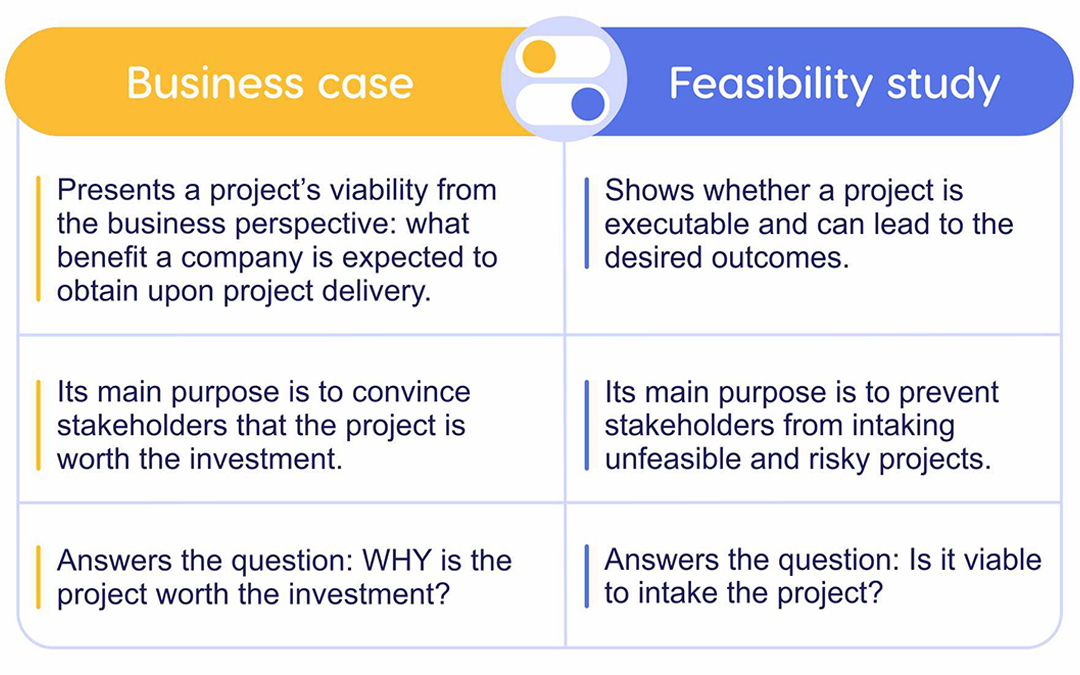Whatever great idea is behind a project, it won’t be implemented without stakeholders’ buy-in and investment. To get their support and approval, they need to understand what value an initiative will bring to their business, or how it’s supposed to solve an existing business problem. This is when a business case document is required. Why is it important, and how to compile a convincing business case? Let’s figure it out in the article.
A Business Case in Project Management: Definition and Importance
According to the Project Management Body of Knowledge [1], a business case is a document that allows decision-makers to determine whether the project is worth the investment. It presents a current business problem and suggests ways to solve it by implementing a certain initiative. The basic purpose of this document is to justify the initiation of a project.
Typically, a business case is created in response to one or several of the following needs:
- Market demand;
- Organizational need;
- Customer request;
- Technological advance;
- Legal requirement;
- Ecological impacts;
- Social need.
A business case is a dynamic document that has to be reviewed and updated regularly. A project manager together with a project sponsor are responsible for monitoring its elements to check whether or not the project is still worth the effort (e.g.: should the project scope be reduced? Is it reasonable to invest more resources to deliver the project?).
Now, let’s examine why it’s important to develop a business case document.
Why create a business case document?
- A business case provides grounds for prioritizing projects across an organization.
It shows what business value can be achieved as a result of project implementation, so that stakeholders can make their decision regarding intaking this initiative.
- It facilitates more reasonable resource utilization.
It makes no sense to allocate valuable resources (both human and material) to projects that won’t bring real value to the business.
- A business case allows stakeholders to set clear expectations of project outcomes.
It increases the chances for meeting their requirements.
- It serves as a reference point throughout the whole project lifecycle.
At the beginning of a project, it provides justification for starting a project. As the project progresses, a business case shows the direction of project work. Upon the project completion, a business case can be used to assess the outcomes.
To sum up, preparing a business case before project initiation can increase efficiency of the business – an organization will intake only those initiatives that will bring real value.
A business case is somewhat similar to a feasibility study, which is why they sometimes get confused. Let’s clear up the difference between them in the subsection below.
A business case vs. a feasibility study
Both a business case and a feasibility study are decision-making tools that present a project’s viability. But still, they have certain differences. Take a look at the table below.

Read more about a feasibility study: To Start or Not to Start: Overview of a Feasibility Study in Project Management
Now, it’s time to consider the exact structure of the business case document.
Components of a Business Case Document
There isn’t any single standard for writing a business case. In addition, some companies have their own templates. Let’s consider one of the variants of this document [2].
Executive summary
This section describes a business problem along with related issues, and how a proposed project is going to address it. As a rule, it’s compiled at the end and summarizes all other sections.
An executive summary creates the first impression of a project. In addition, it may happen that some decision-makers will read only this section. So, make sure that it covers the most relevant information about the initiative.
Here are the proposed components of the executive summary.
- Problem: this section should briefly describe an issue to be addressed.
- Expected outcomes: how will the business benefit from the implementing the proposed project?
- Recommendations: this part describes in what way the proposed project is going to resolve the outlined business problem and how desired results will be achieved.
- Justification: why implement the proposed project? How does it differ from other alternatives? What consequences will the business face in case of declining the initiative?
Business case analysis team
This section describes the roles of employees responsible for developing a business case and describes their responsibilities. They can be as follows: executive sponsor, technology support, process improvement, project manager, and software support.
Problem description
This section should cover the following aspects:
- Problem statement (it can be process-, technology-, or product-oriented);
- Organizational impact: how will the proposed project transform the existing organizational processes, tools, hardware, and/or software;
- Technology migration: this subsection is required when a project involves the implementation of new technologies and data migration from legacy systems.
Overview of a project
This section should provide the most comprehensive information about a project and describe it in the following way:
- Project description presents the approach that will be used to solve the outlined business problem, a project’s components, purpose, and the way it will be implemented;
- A list of business goals and objectives and how the project is expected to achieve them;
- Project performance section describes the criteria to assess project outcomes in relation to key resources, processes, or services;
- Project constraints (e.g., limited resources or budget); this list is preliminary and will be extended upon project plan development;
- Major project milestones: this subsection presents a rough milestone schedule, so that stakeholders can get the idea of an approximate timeline.
Strategic alignment
This section should describe how the project outcomes will be aligned with goals and objectives of an organization’s strategic plans.
Cost-benefit analysis
This is one of the most important sections of a business case. Cost-benefit analysis involves the use of measurable financial metrics (earned revenue or costs saved as a result of project implementation) to make a decision regarding a project initiation. Its main purpose is to illustrate that the benefit a company gets will outweigh the investment.
Alternative analysis
One of the compulsory elements of a business case is presenting possible alternatives to a proposed project, which should include the following information:
- the list of all possible alternatives (including “status quo”, i.e., doing nothing to address the problem) and their consequences;
- the reasons for not selecting other alternatives;
- the substantiation for selecting a particular project among other options.
If approved, a business case document should be signed by decision-makers at the end.
Compiling a business case is a rather labor-consuming task that requires collaboration of members from different departments as well as senior management. At the same time, the process of creating this document is always accompanied by uncertainty to some extent – you cannot predict the project progress with hundred-percent accuracy. This is where a resource management solution can assist. Let’s take a closer look.
How a Resource Management Solution Assists in Creating a Business Case
Suppose that a company has already a number of projects in the pipeline, and its resources are limited. When initiating a project and preparing its substantiation, you need to know whether they have the capacity to work on one more project, or you’ll have to hire more people. It will have a direct impact on estimated project costs, and it will be impossible to perform cost-benefit analysis without this information. However, an AI-driven resource management solution can provide you with the following information.
- Resources’ current and future workload: it analyzes team members’ involvement in active projects and predicts their capacity in the future. So, decision-makers will know the number of employees they can rely on for implementing a new project.
- The impact of adding one more project to the current environment: RM solution’s predictive capabilities make it possible to find out how team members’ current load will change upon adding a new project to the pipeline. You can also make any changes to the project environment (move milestones, add resources, etc.) and see the outcomes of these changes.
Therefore, when developing a business case, you can rely on the information provided by a resource management solution when it comes to resources’ capacity and corresponding costs.
The above-mentioned functionality along with other helpful features are available in Epicflow, AI-driven resource management solution for multi-project environments. It provides project and resource managers with reliable assistance in terms of maximum efficient resource utilization and streamlined project flow. Learn more about our solution by booking a call with our expert.
References
- A Guide to the Project Management Body of Knowledge. 5th Edition.
- Business Case Template. Project Management Docs.


Now the fundamental of business case is clear for me for the first time. Really thank you.
Thanks for your feedback!